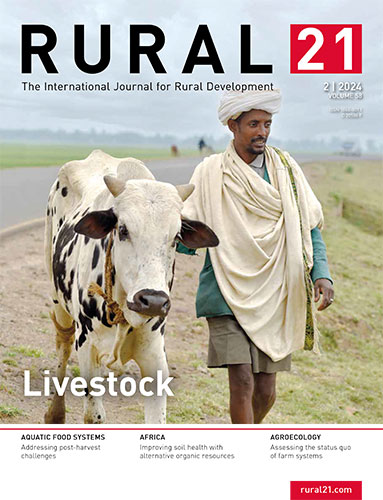- Share this article
- Subscribe to our newsletter
Family farming – the backbone of sustainable rural development?
 Family farming is one of the most predominant forms of agriculture world-wide, both in developing and in developed countries. The sector comprises a wide spectrum of farm sizes and types, ranging from very large land holdings in high-income economies that are easily cultivated by one or two family members with the use of labour-saving machinery and hired labour to the small holdings of a few hectares or less in low-income economies. The latter are often oriented towards subsistence with low marketable surplus. These small family farms, run by small producers are by far, the most numerous: globally, there are approximately 500 million small family farms, 280 million of which are in China and India alone (IFPRI, 2007). Thus, although family farmers and small producers are not identical groups, they share much common ground and hence face a series of similar issues.
Family farming is one of the most predominant forms of agriculture world-wide, both in developing and in developed countries. The sector comprises a wide spectrum of farm sizes and types, ranging from very large land holdings in high-income economies that are easily cultivated by one or two family members with the use of labour-saving machinery and hired labour to the small holdings of a few hectares or less in low-income economies. The latter are often oriented towards subsistence with low marketable surplus. These small family farms, run by small producers are by far, the most numerous: globally, there are approximately 500 million small family farms, 280 million of which are in China and India alone (IFPRI, 2007). Thus, although family farmers and small producers are not identical groups, they share much common ground and hence face a series of similar issues.
Here, family farming is defined as a means of organising agricultural, forestry, fisheries, pastoral and aquaculture production which is managed and operated by a family and predominantly reliant on non-wage family labour, including both women’s and men’s. Indeed, family farmers produce most of the food consumed in developing countries, and use over 80 per cent of the land in Asia and Africa. Despite its prevalence, the central role that family farming plays in food security is not often discussed. While it is not the premise of this article to advocate for family farming as an alternative to commercial farming, or to shy away from acknowledging its links with poverty, it should be said that family farming can be a viable form of agriculture, provided that certain conditions are present. However, it does not take too much to realise that these conditions are in fact generally lacking, and this has triggered an important debate on the future of family farming, which will culminate in the International Year of Family Farming (IYFF) 2014, an initiative launched by the World Rural Forum (WRF) in collaboration with the government of the Philippines, facilitated by the FAO and endorsed by the UN General Assembly.
Understand family farmers’ motivation
Even though family farming may not appear as neat and scientific as commercial farming, there are significant gains to be made by supporting family farming more effectively. One of the main reasons is that as the family and the farm are linked and co-evolve, they combine not only economic functions but also a range of other ‘hidden’ functions, including environmental, reproductive, social and cultural ones, often in lieu of state institutions or the private sector. Environmental functions can include soil enrichment, carbon sequestration, water purification, pest control, pollination and biodiversity enhancement. Reproductive and social functions include childcare, nutrition, water and energy provisioning, education, health, social security, insurance and risk management. Cultural functions include transmission of identity, symbolic and religious values of resources and territories, knowledge and technologies. In performing all these functions, family farming is also often a means of maintaining family patrimony, cultural heritage, territories, landscapes, and communities. As a result, the motivations of family farmers often go far beyond profit maximisation, to encompass social, cultural and ecological aspects.
It is therefore no coincidence that family farming should be such a predominant form of agriculture. The multiple motivations that confront family workers, in contrast to hired workers, and especially the strong incentive to work for the sake of their own families’ well-being, greatly reduce the supervision costs associated with agricultural labour. Moreover, because family farmers often have intergenerational bonds with the holdings they work, their production also frequently provides continued ecosystem services and care for the natural resource base. Because of this, family farming is particularly well suited to holdings characterised by a highly diverse set of economic activities and mosaic-type landscapes, in which the supervision and knowledge required for numerous small and on-the-spot production management decisions is most efficiently and cost-effectively devolved to family workers.
In this respect, it would not be a stretch to posit that there is a correlation between the supervisory advantage of family farming and the way the land looks: whereas family workers, in the absence of widespread mechanisation, are suitable for mosaic type landscapes, the supervisory costs associated with hired labour would generally only be amortised with work on monoculture holdings. In essence, a family worker is better positioned to make semi-autonomous decisions on different micro niches of the farm in ways that reflect the best interests of the farm family and the environmental resources at hand. The incentive of eventual indirect gain that each family member enjoys is thus quite different from that of hired labourers, who rather respond mostly to wages for specific predefined tasks – a situation which does not fit well with landscape complexity. Supporting family farming would therefore also be giving preference to a specific type of landscape and set of traditions that are more conducive to biodiversity preservation, ecosystem balance, and good environmental stewardship.
Once again, this is not an ‘either/or’ case between family farming and large-scale commercial farming. However, even though it is clear that family farming has considerable advantages over large-scale commercial farming, it comprises a form of agriculture that is poorly documented and largely forgotten in relevant discussions, either in international fora or at the national level between agricultural, poverty reduction, and social affairs institutions. This is precisely what the International Year of Family Farming (IYFF) seeks to redress. The major aim of the IYFF will be to raise the profile of family farming and smallholder farming by focusing the world’s attention on their key role in alleviating hunger and poverty, providing food and nutrition security, improving livelihoods, managing natural resources, protecting the environment, and leading towards more sustainable development, in particular in rural areas.
The flipside of the coin
This is undoubtedly a positive development. Yet the rosy picture painted so far of family farming must be tempered with some limitations. Firstly, even though the lower supervision costs make family farming relatively productive in developing countries, the number of economically active family members often limits the scale of production that is possible, unless families have access to mechanisation or are organised into producer organisations and co-operatives. Moreover, it is frequently the case that family farms operate on highly fragmented land that is divided into several parcels, which further reduces the opportunities for economies of scale. Also, family farmers are often poor because they have limited bargaining power and capacity to defend their interests in markets, and their response to market incentives is frequently constrained by the limited market and technical opportunities available to them. Because family farms combine production and consumption objectives, the relatively high proportion of basic consumption within the budget of poor families can also constrain their responsiveness to market incentives.
Furthermore, family farming relies upon family members with different labour power, skills, capacities, opportunities and constraints, which vary in part depending upon gender and age. These characteristics influence intra-household relations, which in turn influence the distribution of resources, roles and responsibilities. Put simply, the intra-household distribution of resources and responsibilities in family farms is often not equitable, especially with regard to women and children. For instance, closing gender productivity gaps associated with unequal access to resources and inputs could raise total agricultural output in developing countries and lead to a reduction in the number of undernourished globally (FAO, 2010–2011). In addition, about 60 per cent of child labour globally occurs in the agricultural sector, most of it in family based and small-scale production. These are unfortunate realities that the family farming model has to reckon with and tackle if it is to enhance its contribution to social and gender equality, intergenerational well-being and human welfare.
Beware of undesirable side effects
Beyond these shortcomings, there are a range of thorny questions that need to be addressed. For instance, would greater support to family farming by agricultural institutions come back as a boomerang in the form of even more child labour, gender disparity, and environmental degradation? Rural survival is about much more than food security: it requires access to energy, infrastructure, public services, and there are key functions in the household that also need to continue to happen. But if the ‘farming’ in family farming is intensified, there is always a risk that the ‘family’ might be accordingly diminished. So for example, how do we ensure that, if food becomes more expensive, children are not made to work more in order to make ends meet on the family farm? Also, if women increase their engagement in agriculture, perhaps as hired labourers, how do we ensure that young children are not taken with them to the field for lack of alternative options, or that rural girls are not taken out of school in order to assume the responsibilities left over in the household? Finally, if more land consolidation projects are implemented to amalgamate fragmented parcels, how do we ensure that the ecological benefits of mosaic landscapes are not sacrificed in the name of efficiency and competitiveness? These are among the issues that the Year of Family Farming seeks to find solutions to in order to enhance the contributions of family farming to sustainable development.
At the moment, the future of family farming in the long run is uncertain. However, the choices we make today could very well determine its future and that of rural development more generally. What is certain is that due to its predominance and advantages, family farming can have a significant role to play in feeding the world, eradicating poverty, ensuring the sustainable management of natural resources and ecosystem services and preserving local cultural heritage. Family farming in low-income economies is often an occupation of last resort, but under the right conditions, could become a country’s backbone of both rural development and national economic growth. Hopefully the International Year will support family farmers by working with all stakeholders, women, men, young and old, to identify new and better ways to enable them to enhance their prosperity, sustainability and freedom to achieve their own aspirations for a better future.
Eve Crowley is Deputy Director of the Gender, Equity and Rural Employment Division at the Food and Agriculture Organization of the United Nations. She is Focal Point for the Post-2015 Development Agenda, and is an anthropologist specialised in rural farming systems and sustainable rural development.
Contact: DorianKalamvrezos.Navarro(at)fao.org
Further reading: IFPRI, Annual Report 2007-2008
FAO: The State of food and agriculture 2010-2011 – Women in agriculture
World Rural Forum




Add a comment
Be the First to Comment